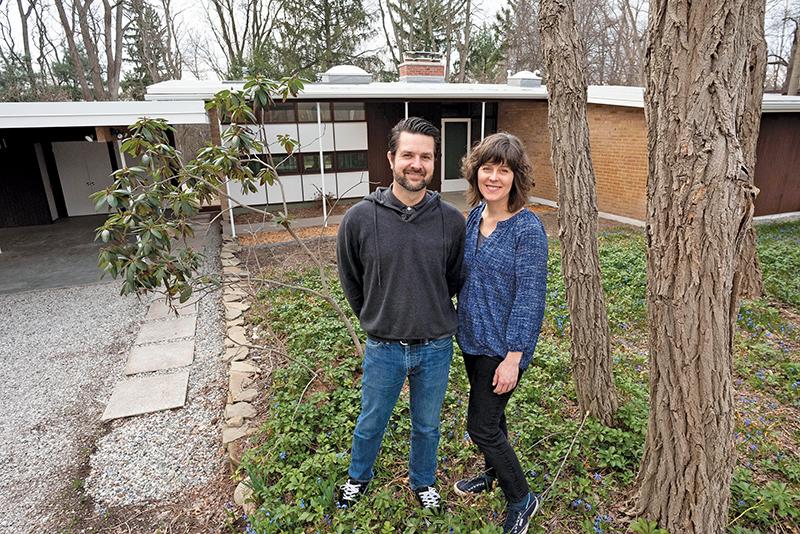The couple–she’s a jeweler, he’s an audio producer–are fans of the sparse, clean-lined Midcentury Modern style. When they moved from Ferndale to Ann Arbor in 2011, they were delighted to find a vintage MCM house in Thornoaks, a small subdivision off E. Huron River Dr.
The only problem was the house next door. It was “in bad shape, complete with boarded-up windows, weeds and moss on the roof, and various animals coming and going at will,” Holkeboer says.
“We moved from a blighted area,” Bolhuis adds. “We couldn’t believe we’d moved into one in Ann Arbor.”
However, they loved the rest of the neighborhood–thirty-two homes, every one in the MCM style. Thornoaks was laid out in 1957 and 1958 by prominent local architect Jim Livingston and builder Eugene Kurtz. They established a building committee–of which they were the sole members–to make sure that designs met their criteria, including how homes were sited on their lots.
Livingston designed about half the houses, including the blighted house in 1959 and Bolhuis and Holkeboer’s in 1964. Livingston and his wife were the newer home’s first residents.
Thornoaks homes are set back from the road on wooded lots, some with views of the Huron River or South Pond. As she explored with their two young children, Bolhuis says, “I knew these houses were special.” At a neighborhood picnic, the couple learned that older residents valued Thornoaks as much as they did–but were concerned about its future.
The guidelines set by Livingston and Kurtz were still in place, but there was no money to enforce them. Long-term residents worried that when moved out, their houses could be torn down and replaced with larger ones in conflicting styles.
When Bolhuis was elected president of the neighborhood group in 2012, she began thinking about creating a historic district but had no idea how to go about it. Help came from the parent of one of her kids’ friends who worked in EMU’s historic preservation program. One day at Buhr Pool, as they were sitting in their wet bathing suits, he suggested she talk to Melissa Milton-Pung, the staff person for the county’s Historic District Commission.
Milton-Pung was excited about the idea and helped them jump through the hoops, even getting them a grant to pay for the required house-by-house report. In April 2018, the Washtenaw County Board of Commissioners voted unanimously to create the first MCM historic district in Michigan.
While Bolhuis was busy with the historic district, things came to a crisis at the blighted house, which had been vacant since a fire in 1986. The people who bought it after the fire mowed the lawn and paid the taxes but never repaired it or moved in.
In 2017, the township threatened to tear down the house and bill the owners for the cost. At that point, the owners approached Bolhuis and Holkeboer to buy it. They paid $78,000–essentially the value of the lot.
After thirty years of neglect, the only interior detail that survived was a wonderful terrazzo floor. “The terrazzo floor saved the house,” says Bolhuis. The couple emptied the house, then took the walls down to the studs. They rebuilt using the original blueprints, with slight changes to bring it up to code. They put in a new sewer line, roof, double-paned windows, insulation, plumbing, electrical, mechanical, kitchen, and bathrooms. Bolhuis had fun choosing fixtures, knobs, and tile of the appropriate period, but compares the eighteen-month rehab to “being pregnant a year and a half.”
“It’s great to be done,” says Holkeboer, “but it was more work than we expected it to be.”
They recently got the certificate of occupancy–and put the house up for sale.



